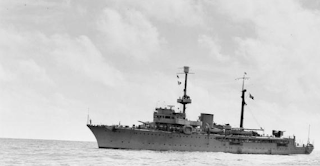 |
| Italian sloop Eritrea entering Sri Lanka to surrender to the British, 1943 |
Recently, a lot of people have asked me what I think the luckiest ship in the war was. Many would highlight the Japanese destroyer Yukikaze which survived major battles without significant damage. Others may point to the American destroyer Fletcher for surviving two major battles of the Savo Islands.
However, I would point to a little-known Italian colonial ship known as the Eritrea.
From East Africa to Japan
Named after the Italian colony in East Africa, this colonial ship was completed in 1937. With the Italian participation in the war against Britain and its allies in 1940, Eritrea was assigned to guard the Italian East African port of Massawa.
By February 1941, the East African campaign was going poorly for the Italians. The defeat at the battle of Agordat, left the port of Massawa wide open for a British advance. From 19 to 22 February 1941, the crew of the sloop Eritrea, and auxillary cruisers Ramb I and Ramb II decided to make a break for the Japanese-controlled territories in Asia.
 |
| Route of the Eritrea in 1941 |
With luck the three ships actually avoided the British blockage at Perim, and left the Arabian sea and entered in the Indian Ocean. This would be the most dangerous part of the journey. The Indian Ocean was controlled by the British ships patrolling from India and Sri Lank.
The New Zealander light crusier Leander spotted Ramb I in the Indian Ocean and sank it on 27 Februrary 1941. After another two close encounters, both remianing vessels managed to reach Dutch-controlled Indonesia (called Dutch East Indies).
Here was the next problem. While the Dutch government had fallen to the Germans, the Dutch still controlled Dutch East Indies. While the Italians and the Dutch were not offcially at war, the Dutch could still report their positions to the British in Singapore or the Australians in Darwin. Thus Captain Ianucci of Eritrea made the decision to disguise both ships as Portuguese vessels. The ruse worked and the two vessels made it past the Dutch East Indies.
After that they encountered Japanese ships and were safety escorted to the Japanese port of Kobe. The Eritrea and Ramb II had spent more than 30 days at sea, and travelled about 17,300 km.
Under Japanese control
As the Eritrea was an obsolete vessel, the Japanese assigned it to escort transport submarines that were operating out of Penang and Singapore. It was not allowed to go on raids or used in an aggressive manner.
Nevertheless, the situation changed in 1943.
From Singapore to Sri Lanka
On 8 September 1943, the Eritrea received news that Italy declared an armistice with the Allies. However their vessel was in the Japanese-controlled Malacca Strait (which was between Singapore and Sabang).
Nevertheless, the crew decided to honor their loyalty to the Italian king and changed course to Sri Lanka 2,500 km away. On 14 September, they finally arrived to surrender to the British forces.
The luckiest vessel
Eritrea and her crew were definitely lucky. Despite being severely undergunned and outdated at the start of the war, Eritrea managed to avoid capture or destruction despite being in deep in enemy territory twice (once with the British and the other with the Japanese).
The Eritrea was eventually sunk as part of a French nuclear test in 1966.
For more information - Comando Supremo
Comments